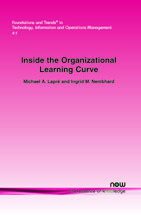Inside the Organizational Learning Curve: Understanding the Organizational Learning Process
By Michael A. Lapré, Vanderbilt University, Owen Graduate School of Management, USA, michael.lapre@owen.vanderbilt.edu | Ingrid M. Nembhard, Yale University, School of Public Health & School of Management, USA, ingrid.nembhard@yale.edu
Abstract
In this work, we aim to provide an in-depth understanding of the organizational learning curve and why significant differences in the rate of learning exist across organizations. We review what is known about organizational learning curves as well as what is unknown. In sum, much is known and much remains unknown. Few studies have "stepped inside the learning curve" to provide greater understanding of the organizational learning process underlying the learning curve. We contend that this understanding is essential for helping organizations learn better and faster, and thus, operate more effectively and efficiently in a dynamic world. Therefore, not only do we examine what is known about organizational learning curves, but also what is known about the organizational learning process. Much of the former research has been conducted by operations scholars, while much of the latter has been conducted by organizational behavior scholars. By integrating research from both (of our) disciplines, we hope to provide a more comprehensive understanding of organizational learning and the venerable organizational learning curve.
Inside the Organizational Learning Curve
Inside the Organizational Learning Curve provides an in-depth understanding of the organizational learning curve and why significant differences in the rate of learning exist across organizations. Few studies have "stepped inside the learning curve" to provide greater understanding of the organizational learning process underlying the learning curve. We contend that this understanding is essential for helping organizations learn better and faster, and thus, operate more effectively and efficiently in a dynamic world. Therefore, not only do we examine what is known about organizational learning curves, but also what is known about the organizational learning process. By integrating research from both operations and organizational behavior disciplines, the authors provide a more comprehensive understanding of organizational learning and the organizational learning curve. Inside the Organizational Learning Curve is organized as follows. It begins by reviewing the definition of organizational learning and where it occurs in organizations. In Section 2, it shifts attention to its primary focus - the organizational learning curve. The authors review various learning curve models summarizing the evidence from these models, which shows tremendous variation in organizational learning rates. Section 3 reviews frameworks for understanding this variation in learning rates and discusses variation that arises from differences in experience, deliberate learning activities, and other key sources. Section 4 examines the relative effectiveness of experience versus deliberate learning activities as sources of learning, and contends that these sources of learning affect performance through a process. Section 5 describes the steps that characterize the learning process inside the learning curve: from learning to better organizational knowledge to changed behavior to organizational performance. The authors discuss the significant challenges organizations need to overcome in order to advance along these steps.
